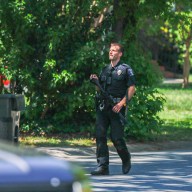 The 1929 feature “The Man With a Movie Camera” played with much of what cinema can do.
The 1929 feature “The Man With a Movie Camera” played with much of what cinema can do.
Credit: Provided
For whatever reason, cinema has been largely used to tell stories. This is fine, but there’s infinitely more that the medium can do — so much potential that even today goes undertapped.
Many filmmakers from the silent era tried to do as much as they could with their still childlike format; you can even see a final, aggressive push to toy with the technology as synchronous sound was taking over. One who tried harder than most was Dziga Vertov, a Soviet tyro best known for 1929’s whirligig “The Man with a Movie Camera,” made, almost in defiance, two years after “The Jazz Singer” popularized the talking picture. You can watch it in its entirety below:
Vertov was a documentarian who believed that film was the best way to rally together the masses to political causes. In fact, he wanted to abolish all non-documentary films.
His own documentaries, it should be noted, aren’t strictly how one would today define “documentary.” They’re filled with aesthetic and technical experiments, as playful in form as they are radical in content. Vertov, like fellow countryman Sergei Eisenstein, thought that politics could best be conveyed through cinema — not just cinema, but fast-paced cinema. He thought aggressive editing would communicate thoughts better than writing them. Indeed, there are few intertitles in either Vertov or Eisenstein’s seminal works. (They were also wrong, and propaganda film later employed more broad, direct methods to poison the masses, thus freeing up future viewers to admire their films for more aesthetic reasons.)
“The Man with a Movie Camera” is different. It’s not politically loaded; it’s about, as the title says, moviemaking itself. It’s part “city film” — part of a trend toward pictures that show off man’s most impressive domination of the planet, namely metropolises — and part series of restless editing and filmmaking experiments. It wanted to show that film could go anywhere and do anything. Vertov plays with trick photography, like having a tiny cameraman (Vertov’s brother Mikhail Kaufman, the film’s cinematographer) working atop another, giant camera, or inside a beer glass. Here, movie theater seats move on their own, cars speed unnaturally down busy streets and the ability to lay images on top of other images create an unnatural visual density. Film creates that which life never could.
There’s nothing else quite like “Man With a Movie Camera,” even if bits of it have seeped all over. (Meanwhile, Vertov’s other brother, Boris Kaufman, also a cameraman, wound up in Hollywood, lensing the beautifully gritty “On the Waterfront,” among others.) Music videos, of course, owe everything to it, though its effects can be felt in anything that conspires to tack one moving image next to, or on top of, or underneath, another. It’s one of the great, sustained single blasts in cinema history.
















